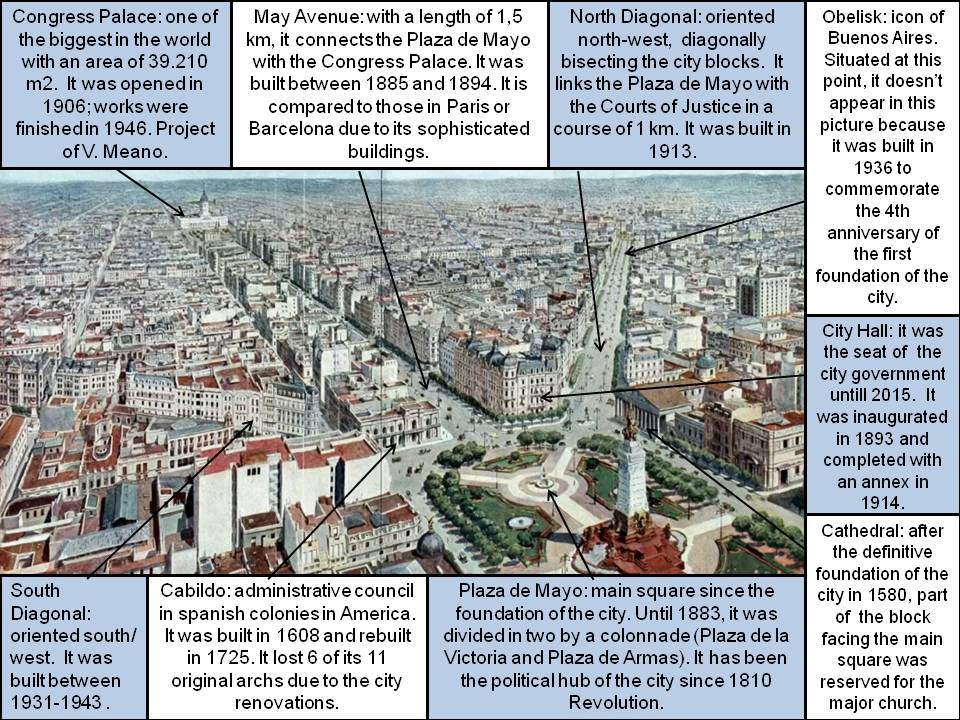BUENOS AIRES (Cándido Villalobos, 1913)
This is a drawing of Cándido Villalobos-Domínguez, a Spanish drawer who immigrated to Argentina in 1905. He was a drawing teacher at Buenos Aires University and also the artistic director of Caras y Caretas, a popular weekly magazine of the time. This picture of Buenos Aires, capital and largest city of Argentina, was retrieved from www.skyscrapercity.com, page 268.
In 1913, he was asked to draw a picture of how Buenos Aires would look like after some planned reforms. The drawing represents the CBD, which is called LA CITY PORTEÑA. It is the core part of the city where the main economical activities take place. In this area we can also find most of the public buildings, such as the Congress, Ministries, Courts of Justice, Central Bank and the Government House, called Casa Rosada. It doesn’t appear in the drawing because it is located on the unseen side of the Plaza de Mayo.
Juan Díaz de Solís, sailor and explorer that served the Spanish Crown, discovered the Río de la Plata in 1546 and twenty years later Pedro de Mendoza founded the first city of Nuestra Señora del Buen Ayre on the western shore of the estuary of this river. In 1580, when Juan de Garay refounded the city with the name Santísima Trinidad, he planned and designed it as a grid. The street layout is perpendicular and the standard size of the city block is 100 m x 100m. As in most Spanish colonies in America, they built around the main square (then called Plaza de Mayo) the Cabildo, the Cathedral and the seat of government, originally a fort which was later replaced by the Casa Rosada.
At the end of the 19th century, population had increased considerably with the arrival of immigrants, mostly Europeans, attracted by the great economic growth due to the income generated by the export of raw materials. By the beginning of the 20th century Argentina had become one of the richest countries in the world. In 1869, according to the first national census, population was 187.126 inhabitants and in 1914 there were 1.575.814 inhabitants. As a result of this population growth, it was decided to start a series of public works in order to build new public buildings, provide the city with more open places and improve traffic circulation. Reforms should respect an aesthetic sense and some of them were inspired by cities as Paris.
In 1885, public works began on May Avenue and were completed in 1894. The avenue’s layout was built through existing urban blocks that were expropiated. It was necessary to demolish part of the north arcade of the Cabildo to make way for the avenue’s entry into Plaza de Mayo. The avenue connects the seat of the executive power, the Pink House, with the Congress. Along its 1,5 km way, we can find sophisticated buildings of art nouveau, neoclassic and eclectic styles.
Two diagonals were pojected from the Plaza de Mayo, one starting at the north- west corner of the square (North Diagonal) and the other at the south-west corner (South Diagonal). The North Diagonal has an extensión of 1 km and links the Plaza de Mayo with the Courts of Justice. One of the most prominent features of the North Diagonal is the constant line of cornices of 67,5 meters high, which gives an overview of continuity along its route.
It is curious to note that some features that appear in the drawing were modified from the original project and some works weren’t carried out. For example, to create room for the South Diagonal, in 1931 the three southernmost arcs were demolished. In the drawing of 1913, the South Diagonal is scheduled without this demolition, that is why the Cabildo kept its five south archs. Villalobos also included in his drawing a big monument in the middle of the Plaza de Mayo that it wasn’t built. At present day we can find a small pyramid in the centre of the square that was erected in 1811 to commemorate the first anniversary of the Revolution, first step towards Independence.
Works above mentioned modernized the city and reflects a time of great economic power of the Argentina Republic. They gave Buenos Aires a rich, cultural and achitectural heritage, making it “the capital of an empire that never existed” (André Malraux).
Inés Ríos Araya

